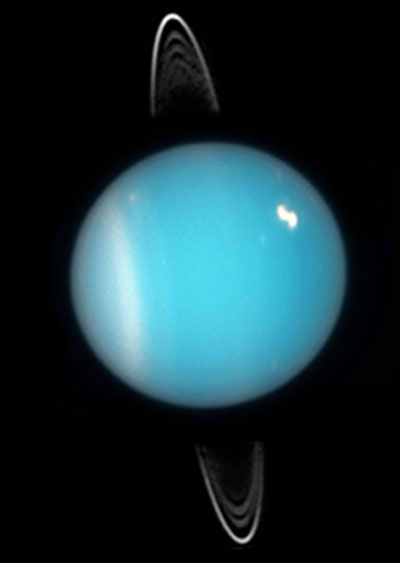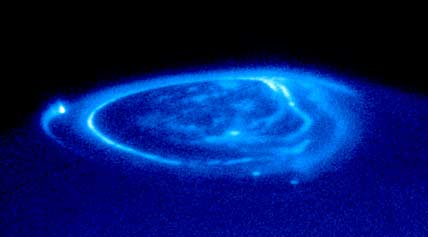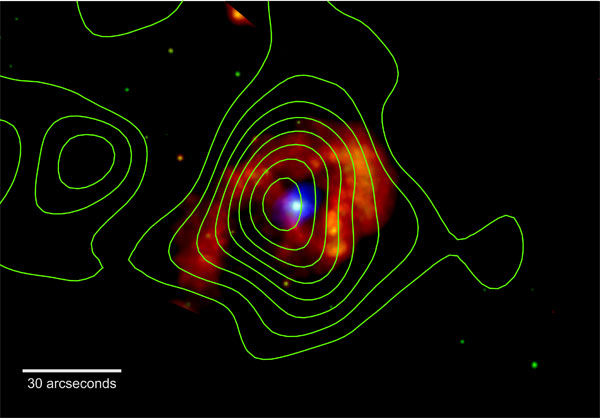This week in astronomy news: A cataclysmic impact shaped ice giant Uranus's evolution, new Juno observations reveal Jupiter's complex aurorae, and NuSTAR provides conclusive evidence that superstar Eta Carinae acts as a cosmic-ray gun..
Cataclysmic Impact Shaped Evolution for Ice Giant Uranus

NASA / ESA / and M. Showalter
Scientists have long known that the strange tilt of the Uranus could only be explained by a terrific impact. Uranus is unlike any other solar system planet in that it’s tipped on its side: The ice giant spins at right angles to the plane in which the planets orbit, so that its poles take turns basking in sunlight. Now, Jacob Kegerreis (Durham University, UK) and colleagues have used high-resolution computer simulations of more than 50 different impact scenarios to see how it tipped over.
The team concludes that the collision, which took place roughly 4 billion years ago, was probably with a rock-and-ice protoplanet at least twice Earth’s mass. Even though the impact was powerful enough to knock over the planet, Uranus managed to hold on to most of its gaseous atmosphere. Some of the lost atmosphere may have helped form the thin rings that encircle the planet today.
The historic collision helps explain a number of the ice giant’s more curious attributes. Its atmosphere is incredibly cold, even for being so far out from the Sun: -216°C (57 K). The simulations suggest that the impactor’s debris could have formed a thin shell of ice within Uranus that traps heat emanating from the planet’s core. The impact could also explain the planet’s tilted and off-center magnetic field.
Read more in Durham University’s press release. The study appears in the Astrophysical Journal.
Jupiter’s Moons and Jupiter’s Aurorae
Jupiter displays beautiful aurorae, created when charged particles rain down along magnetic field lines and interact with the planet’s upper atmosphere. But unlike the ethereal Northern Lights on Earth, Jupiter’s nearest and largest moons contribute charged particles to the giant planet’s aurorae, creating permanent spots of light that follow the moons’ orbits.

Now, scientists analyzing new observations of those auroral spots from NASA’s Juno spacecraft have realized that these contributions aren’t as simple as they once appeared. While lower-resolution observations have long showed that the volcanic, ion-spewing moon Io produces a bright spot within Jupiter’s aurorae, Juno’s higher-resolution observations have shown that that spot actually has two tails that trail for 100 degrees around the planet, reminiscent of a dragonfly’s wings in appearance. Ganymede, Jupiter’s largest moon, also leaves a more complicated footprint in the aurorae, with one brighter spot preceded by a dimmer “precursor” spot.
The observations show that the magnetic interactions between Jupiter’s upper atmospheres and its moons is more complicated than once thought. Alessandro Mura (National Institute for Astrophysics, Italy) and colleagues publish these results in the July 6th Science.
Eta Carinae: Superstar and Cosmic Ray Gun
Eta Carinae is one of the most luminous and massive stellar systems known: a pair of stars with 90 and 30 times the Sun's mass that whirl around each other every 5.5 years. When they come close together in their oval-shaped orbits — only 140 million miles apart, roughly the same as the average distance between the Sun and Mars — their powerful stellar winds collide. In the June 2nd Nature Astronomy, Kenji Hamaguchi (University of Maryland) and colleagues report that these colliding winds act as a cosmic ray gun, shooting energetic particles all over the galaxy.
Chandra X-ray Observatory measurements have shown that the colliding winds produce low-energy X-rays, but it wasn't 100% clear where the X-rays were coming from. The Fermi observatory has likewise hinted at high-energy gamma-rays coming the system, which would suggest that energetic particles are to blame for the radiation, but the images are too fuzzy to make sure.

NASA / CXC and NASA / JPL-Caltech
Now, NuSTAR has added its own, high-energy X-ray images to the mix, providing the needed connection between the sharp low-energy measurements and the fuzzier high-energy measurements. The observations conclusively show that the colliding stellar winds act as a cosmic particle accelerator, producing relativistic particles that, when released, go careening through the galaxy and — eventually — toward Earth.
For an in-depth look at Eta Carinae and how our understanding of this system is evolving, see Sky & Telescope's October 2016 issue.
See NASA's press release for more details on this study or watch their fantastically illustrated video summarizing the results:
 6
6
Comments
Bob
July 7, 2018 at 6:09 am
Monica...
The NASA video is amazing. Thanks for sharing.
Bob
You must be logged in to post a comment.
Lindsay
July 13, 2018 at 7:04 pm
Nice summary, Monica.
So I see how Eta Czrinae is a cosmic Ray Gun (BTW, I found the background music in the NASA video annoying so I put it on mute)-- a fascinating star system. But I recall reading somewhere that 90+ percent of cosmic rays hitting Earth are protons from our Sun -- is that right?
You must be logged in to post a comment.
Lindsay
July 13, 2018 at 7:20 pm
Oops, I got that wrong. They come from beyond our Solar System, but 90% are high-energy protons? Are we even able to measure the percentages (distribution) of the various masses of the ions hitting the Earth?
You must be logged in to post a comment.
Rathgic
July 15, 2018 at 3:52 pm
I'm sorry but as far as Eta Carinae being a binary star system of relatively equal masses is concerned .... it is one of many ways in which the astronomy intellectual community ..... continues to repeat the inexcusable mistake illustrated by their instance to the point of killing people .... that disagreed .... FOR 1500 years that the piddly earth was the center of rotation of ALL THE ZILLION OF STARS IN THE UNIVERSE. You'd think they would have at least chosen to our sun, upon who's heat source their survival depends. And obvious before any star could rotate around the earth, the earth would have had to be in existence to do so. But no one has ever bothered to ask the question much less answer it, "why did so many perpetuate the same inexcusable mistake .....which is obviously an unworkable premise and NEWER HAPPEN THAT WAY NOR ANY RATIONAL REASON WHAT IT WOULD! And so the result is to be expected ..... the same type of reason for having done so ... continues to exert its influence and the same types of mistakes are made over and over. Just like Newton. He "said" that it was wrong and for some unexplained reason, it was the catalysis for others to follow .... but if you examine his ''reasoning", he did not demonstrate his was any better than the previous was.
Newton was quite wrong about almost everything he wrote. Not the least of which is that his "Law" that for every action their is an equal and opposite force created is absurd and inexcusably so. Motion would not be possible to create it .... if every time you applied a source to do so there was an equal and opposite force applied. Motion requires an imbalance of forces. Indeed, motion itself is an example of forces that are NOT in balance BUT BIASED IN THE OBSERVED DIRECTION OF MOTION.
I have also taken the time to try and determine why Newton made his mistakes. And we are fortunate, the reason for the mistake is revealed in his own words as he describes his thought processes and what motivates him to make decisions! That same thought process was obviously what was also used in the persistence of the unworkable decision of the role of the piddly earth mistake.
In fact, orbits are not formed by "mathematical" equality formulas and certainly not by "centrifugal force" from the center of rotation outward! That one of the axis "halves" equal in length, but the other has one shorter than the other ..... means that there MUST BE AND IS an inequality in what happens in one half of the orbit divided by the minor axis that DOES NOT HAPPEN IN THE OTHER and some means must be available to accommodate the different and reverse itself with each orbit!
There is in fact, like most things in the reality into which all humans were born ..... THAN WE CAN DO NOTHING ABOUT ..... of forces and relationships from the biggest to the micro smallest formed over billions of years ..... by constant adjustment of those that continue to exist .... by FEEDBACK MECHANISM that causes them to related to each other in a "zig zag" path over a middle ground as it is constantly encountering "different" circumstances. Something a mathematical "equality" system of formulas simply can not comprehend much less deal with.
And that feedback system as applied to orbits, obviously require the center object to be far more massive than the orbiting bodies ..... in order to create the mutual feedback back system of the gravity force of the center object and the tangential force of the orbiting body. It solves the problem by reversal that the current theory of how orbits form and continue cannot do. Using a circle orbit for descriptive reference question what happens when the earth gets outside of the "equality" position of balanced gravity and tangential force. As must happen to have two halves that have different quantities? The gravity gets less .... with distance as we all know. So then what occurs to ultimately bring in back into a closer distance. If gravity couldn't do it in the first place, then a less gravity further out certainly can not ..... in an "equality" formula thinking process.
The fact is that the Feedback mechanism is always adjusting the application of forces back and forth across, the middle ground and when it get further apart it has the capacity of reversing itself to bring the orbiting body back towards the middle and then crosses over ..... only to have that motion less and less until it reverses itself. Which is particularly neat because when like currently Saturn and Jupiter are both out side of us towards the sun and their gravity, tho minor in comparison with the sun, .... none the less adds a little more outward force to the sun earth problem of keeping the orbit within bounds that the feedback system can continually handle of zillions of years. Well, that "minor" adjustment to the orbit system is no different that the "minor problem" the orbit had when it was first created ....that just happen to be within the feedback's ability to monitor and adjust. That's why sometimes "potential" orbits are formed and other's are not. If the feedback can not handled changing the approach phases to an orbit phase then they just pass each other by ..... except in the case of small objects that can not contend with the ever increasing gravity force of the central more massive body and then, as we see meteorites do all the time, when the forces are merged to the point of collision to and a different kind of "workable" relationship is created!
You must be logged in to post a comment.
Rich
July 18, 2018 at 5:41 pm
Einstein taught us that reality is not what it seems, neither is gravity. He classified gravity as a pseudo-force, but gravity offers real consequence’s if you challenge its authenticity. No one knows what it is or where it comes from. It doesn’t react like any other force in nature. We haven’t been able to shield it, counter it, or reduce its intensity. If any significant progress is to be accomplished in this field of endeavor, new avenues of thought must be pursued.
Many people don’t realize that the current models are incomplete. Newton’s theory doesn’t explain how matter attracts matter. Einstein’s theory doesn’t explain how a reduction in surface density causes a change in the earth’s gravitational field. These variances can’t be justified by an external event such as the bending of the space-time continuum. It is more likely that gravity results from an internal event caused by the presence of a large mass.
The word gravity comes from the word gravitate, which means to be attracted or drawn to. Sir Isaac Newton did not discover gravity, but he did devise a theory describing the force. In the expression below, Newton devises a method to determine the tension on a string when an object is rotated. The force directed inward toward the center of rotation is known as centripetal force.
f = (mv^2)/r
Newton reasons that the force supporting a body’s orbit must also be centripetal in nature. He then applies this principle to a space environment.
F ne t= (M planet v^2)/r
In Newton eyes, the circular rotation of the planets can be easily explained if masses attract. Newton’s Universal Law of Gravitation achieves a value for the force acting between two masses at a given distance.
F gravity = G (M planet x M sun)/r^2
To justify the Universal Law of Gravitation, Newton reasons that net force must equal gravitational force.
F net = F gravity ∴ M planet v^2/r = G (M 1 x M 2)/r^2
Newton assumes that centripetal force in a surface environment works identical to centripetal force in a space environment. It turns out that gravity is far more complicated than Newton thought. The augmented theory of gravitation proposes that the field binding an object to a planet’s surface is the same field gripping a satellite.
g = (v^2 R)/r^2 (centripetal force in a space environment)
g = centripetal gravity force exerted on a satellite m/s^2
v = mean orbital velocity of satellite m/s
R = semi-major axis of satellite m
r = radius of planet m
t = orbital period of satellite sec
Mars’ centripetal gravity calculated from the orbit of a satellite.
r v R
Equatorial radius Mean orbital Semi-major axis
of Mars velocity of revolution
3.396 x 10^6 m g = (v^2 R)/r^2
Name m/s x 10^ 6 m/s^2
Phobos 2,138.2 9.377 3.71
Deimos 1,351.6 23.464 3.71
Mariner 9 1,813.3 13.0565 ________
Mars 2 1,608.0 16.584 ________
Mars 3 657.8 99.494 ________
Mars 5 1,432.8 20.524 ________
Viking 1 1,454.5 20.551 ________
Force of surface gravity on Mars determined by NASA 3.71 m/s^2
The new augmented theory proposes that gravity is the result of a mass-induced vortex. It is a field initiated by the movement of liquid space from the third into the fourth dimension through a body’s surface.
If you plunge into a streaming river, the current will pull you along in the direction of the rivers flow. The water did in no way attract you, its powerful current sweeps you away. Gravity is not at all like magnetism, rather gravity is the attractive hold a large mass has on a smaller caused by a streaming current.
The force exerted between a large body and a satellite is not a mutual force. Although the large body has a grip on the small body, the small body has no such grip on the large body. Under normal circumstances, the force which keeps a body with gravity in orbit is the same as, the force that keeps a body without gravity in orbit.
Therefore, the orbit of a satellite can be easily explained as the balance between a satellites velocity and the force exerted by a large body.
Newton’s premise that matter attracts matter allows him to solve for a nonexistent force (F) between masses. It’s unfortunate that many other prominent physicists have followed in his quake.
A new approach for the cause of gravity is found in the book, "Taking on Gravity: A Guide for Practical Gravitation."
You must be logged in to post a comment.
millerf1
July 22, 2018 at 12:43 pm
That may be what happened to planet X. It hit Uranus.
You must be logged in to post a comment.
You must be logged in to post a comment.